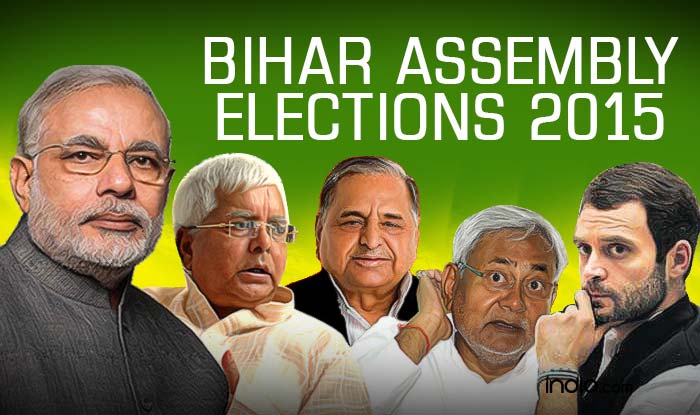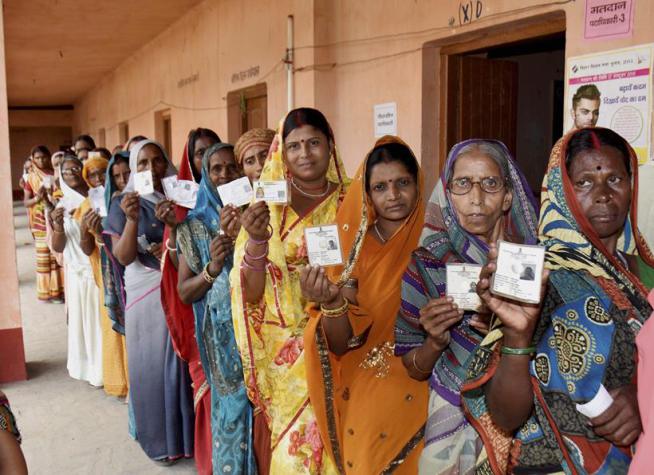The Bihar assembly election is to be held in five-phases in October–November 2015 as the tenure of the current Legislative Assembly of Bihar ends on November 29, 2015. Phase I was conducted on October 12, 2015.
To find out more about Bihar assembly election, click on this link.

Phase I – Bihar Assembly Election
Around 57 percent of the 13.5 million electorate voted on Monday, October 12, 2015 in 49 of the 243 constituencies in the first round of battle for political power in Bihar assembly election. The two main fronts, the NDA and the alliance under Nitish Kumar, soon claimed victory.
Phase I on October 12, 2015 marked the start of an intense five-phase contest that will end on 5 November, 2015 and whose outcome – which to be known three days later on 8th October 2015 – will prove whether the Prime Minister Narendra Modi still retains his charisma or not. The Phase II of polling will be held on 16 October, 2015.
Fronts of Bihar assembly election
The Janata Parivar group, that is, a group of six parties-
- Samajwadi Party,
- Janata Dal (United),
- Rashtriya Janata Dal,
- Janata Dal (Secular),
- Indian National Lok Dal and
- the Samajwadi Janata Party (Rashtriya),
The group announced to fight the Bihar assembly election jointly under Nitish Kumar’s leadership, which was joined by the Indian National Congress and the Nationalist Congress Party.But later the group was left by all except JD(U), RJD and INC.
On the other hand of the Bihar Assembly election, Bharatiya Janata Party led NDA front is fighting Bihar assembly election alongside the Lok Janshakti Party, the Rashtriya Lok Samata Party and the Hindustani Awam Morcha.
To know more about major parties in the Bihar assembly election, click here.
Voting in Phase I
Samastipur, Begusarai, Khagaria, Bhagalpur, Banka, Munger, Lakhisarai, Sheikhpura, Nawada and Jamui districts were the ones who voted in Phase I of the Bihar assembly election.
Bihar officials said that the voters in over a dozen villages in Samastipur, Bhagalpur, Jamui and Banka boycotted the polls and shouted slogans against what they said was the lack of development in Bihar.
In areas of Maoist influence, the voting ended at 3 pm.
Long queues of voters were mostly seen in the rural areas. In the urban areas, voters did not show much enthusiasm. It is usually said that the BJP gets major support from the urban middle class and ‘the grand alliance’ of Nitish Kumar and Lalu Prasad get their supporters in the rural areas.
While the National Democratic Alliance was relieved over the increased voting percentage in the Phase I of Bihar assembly election, ‘the grand alliance’ felt that the trend would work to its advantage.
Women voters in Bihar outnumbered their male counterparts by five per cent.
The Bharatiya Janata Party (BJP) led NDA is determined to oust the ruling JD(U) party and its allies, that is the RJD and Congress who had formed a Grand Alliance.
Additional Chief Electoral Officer R Lakshaman said the Bihar assembly election passed off peacefully, with 57 percent voting in 2015. The percentage was nearly 51 percent in 2010.
Defying the Maoist calls to boycott the elections, millions of men and women in both the urban and rural areas in Bihar trooped to the polling booths in the 49 constituencies spread over 10 districts, according to the officials.
Barring a few stray incidents, the balloting for Phase I was largely peaceful.
Tight security arrangements were made with deployment of Central paramilitary forces at every booth and in the Maoist-affected districts of Jamui, Lakhisarai, Munger and Nawada, five helicopters and three drones were deployed for surveillance. Altogether 110 persons were arrested and some vehicles seized.
Unidentified men fired at the Lok Janshakti Party (LJP) candidate Vijay Kumar Singh in Jamui, but he was unhurt and the police arrested one of the attackers.
Minor incidents of violence were reported from the Banka, Jamui and Bhagalpur districts.

The heavyweights in the fray during Phase I included the state LJP president Pashupati Kumar Paras, the BJP ally HAM state president Shakuni Choudhary and the Congress leader and former speaker Sadanand Singh.
The JD(U) and the Rashtriya Janata Dal came together for this Bihar assembly election after years of hostility.
Comparision of 2010 and 2015 Bihar Assembly election
In the Phase I of the last Assembly poll that was held for the same number of seats, the JD(U) had picked up 29 seats, the BJP 13, the RJD 4, while the Congress, the CPI and the Jharkhand Mukti Morcha got one seat each.
This time in the Phase I of Bihar Assembly election, the JD(U) put up 24 candidates, the RJD 17 and the Congress 8 candidates.
Click here to find out more about the Bihar assembly election.
The result of 2015 Bihar Assembly election Phase I remains to be seen.
Comment Policy [Please read this before posting your comments]: Only use your real name. Your words are your own, so be nice and helpful if you can. Please, do not share any personal information in your comments. For further details, please read our Comments Policy available over here.